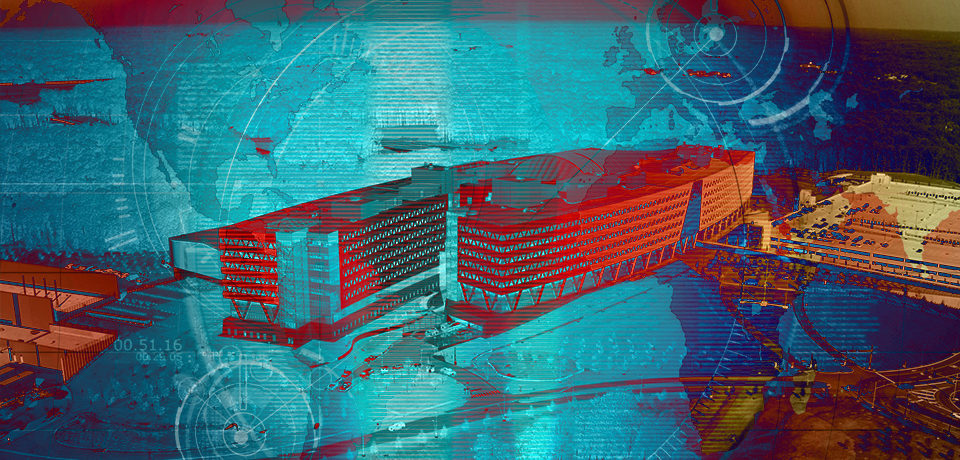Despite its lack of name recognition, the NGA's headquarters is the third-largest building in the Washington metropolitan area, bigger than the CIA headquarters and the U.S. Capitol.
Completed in 2011 at a cost of $1.4 billion, the main building measures four football fields long and covers as much ground as two aircraft carriers. In 2016, the agency purchased 99 acres in St. Louis to construct additional buildings at a cost of $1.75 billion to accommodate the growing workforce, with 3,000 employees already in the city.
The NGA is to pictures what the NSA is to voices. Its principal function is to analyze the billions of images and miles of video captured by drones in the Middle East and spy satellites circling the globe. But because it has largely kept its ultra-high-resolution cameras pointed away from the United States, according to a variety of studies, the agency has never been involved in domestic spy scandals like its two far more famous siblings, the CIA and the NSA. However, there's reason to believe that this will change under President Donald Trump.
Throughout the long election campaign and into his first months as president, Trump has pushed hard for weakening restraints on the intelligence agencies, spending more money for defense, and getting tough on law and order. Given the new president's overwhelming focus on domestic security, it's reasonable to expect that Trump will use every tool available to maintain it, including overhead vigilance.
In March 2016, the Pentagon released the results of an investigation initiated by the Department of Defense's Office of Inspector General to examine military spy drones in the United States. The report, marked "For Official Use Only" and partially redacted, revealed that the Pentagon used unarmed surveillance drones over American soil on fewer than 20 occasions between 2006 and 2015. (Although the report doesn't identify the nature of the missions, another Pentagon document lists 11 domestic drone operations that principally involved natural disasters, search and rescue, and National Guard training.)
The investigation also quoted from an Air Force law review article pointing out the growing concern that technology designed to spy on enemies abroad may soon be turned around to spy on citizens at home. "As the nation winds down these wars ... assets become available to support other combatant command (COCOM) or U.S. agencies, the appetite to use them in the domestic environment to collect airborne imagery continues to grow."
Although the report stated that all missions were conducted within full compliance of the law, it pointedly noted that as of 2015 there were no standardized federal statutes that "specifically address the employment of the capability provided by a DoD UAS (unmanned aircraft system) if requested by domestic civil authorities." Instead, there is a Pentagon policy governing reconnaissance drones that requires the secretary of defense to approve all such domestic operations. Under these regulations, drones "may not conduct surveillance on U.S. persons" unless permitted by law and approved by the secretary. The policy also bans armed drones over the United States for anything other than military training and weapons testing.
In 2016, unbeknownst to many city officials, police in Baltimore began conducting persistent aerial surveillance using a system developed for military use in Iraq.
Few civilians have any idea how advanced these military eye-in-the-sky drones have become. Among them is ARGUS-IS, the world's highest-resolution camera with 1.8 billion pixels. Invisible from the ground at nearly four miles in the air, it uses a technology known as "persistent stare" — the equivalent of 100 Predator drones peering down at a medium-size city at once — to track everything that moves.
With the capability to watch an area of 10 or even 15 square miles at a time, it would take just two drones hovering over Manhattan to continuously observe and follow all outdoor human activity, night and day. It can zoom in on an object as small as a stick of butter on a plate and store up to 1 million terabytes of data a day. That capacity would allow analysts to look back in time over days, weeks, or months. Technology is in the works to enable drones to remain aloft for years at a time.
The Department of Homeland Security has been at these crossroads before. In 2007, during the presidency of George W. Bush, the department established an agency to direct domestic spy satellite stakeouts and gave it a bland name: the National Applications Office. But Congress, concerned about a "Big Brother in the Sky," cut off funding. In 2009, it was killed by the Obama administration.
Still, unlike domestic electronic surveillance by the NSA, which has been closely scrutinized and subjected to legislation designed to protect civil liberties, domestic overhead spying has escaped the attention of both Congress and the public. The Trump administration may take advantage of that void.
Comment: Huh? What is the author talking about? The idea that the NSA is closely supervised via FISA courts, Congressional oversight - or anything else, is a total charade. The NSA is largely an entity unto itself and makes it, like other so-called intelligence agencies, very dangerous for the world of non-pathological people.
Initiating a new age of "persistent surveillance," Trump could use the spy world's overhead assets to target Muslims or members of Black Lives Matter. The president has spoken in favor of increasing the scrutiny of mosques; aerial assessment would allow him to track worshippers. Drones could aid in the mass roundup of illegal immigrants intended for deportation, and Trump has said he may send federal forces to Chicago to quell the violence. Drones could offer the city the unblinking eye for 24/7 vigilance.
Of course, all that would require a significant expansion of the National Geospatial-Intelligence Agency to analyze the domestic imagery. Before that can happen, Trump, like Obama, has to discover there is such an agency.




Reader Comments